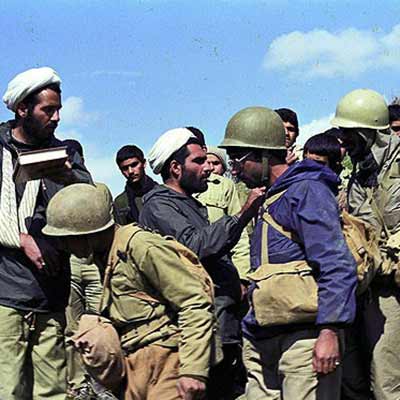Battles
Operation Nasr 4
Leila Heydari Bateni
235 دورہ
In 1987, Operation Nasr 4 was launched under the command of the Islamic Revolutionary Guard Corps (IRGC), to advance towards Iraq’s Sulaymaniyah Province. The operation concluded successfully with the capture of the Iraqi city of Mawat and the liberation of the surrounding heights.
Operation Nasr 4 was carried out in northern Sulaymaniyah Province, Iraq, along the high and continuous mountain ranges of Gamo, Hezarkaniyan, Balukaveh (commonly known as the Twin Hills), Qashan, Golan, Zhajileh, Balusah, and Garderash. In addition to these strategic heights, the region included several villages and the city of Mawat which was located 35 kilometers inside Iraqi territory and 75 kilometers from the Iranian city of Baneh. The Qale Chulan River ran through the city, dividing it into eastern and western parts. Following Operation Karbala 10 on April 19, 1987, Mawat had come within the firing range of Iranian forces.[1]
Two battalions of the 14th Imam Hussain (as) Division, four battalions of the 25th Karbala Division, three battalions of the 105th Quds Division, three battalions of the 57th Hazrat Abolfazl (as) Division, four battalions of the 41st Tharallah (as) Division, five battalions of the 33rd al-Mahdi (as) Division, two battalions of the independent 11th Amir al-Muminin (as) Brigade, two battalions of the independent 35th Imam Hassan (as) Brigade, two battalions of the 32nd Ansar al-Hussain (as) Division, the 155th Special Martyrs Division, the independent 59th Muslim ibn Aqil Brigade, and the independent 38th Zulfaqar Armored Brigade participated in this operation under the command of Najaf Headquarters.[2]
Since capturing Mawat was impossible without securing the overlooking heights, the operational area was divided into four sectors namely the western ridge of the Golan and Zhajileh heights, the Qashan ridge up to peaks 1, 2, and 3, and the city of Mawat, the Miraveh and Balukaveh ridges, known as the Twin Heights, and the plains stretching from Baluseh to the western part of Qashan.[3]
Led by the IRGC, Operation Nasr 4 began at 2 AM on June 21, 1987, along four fronts with the code-name: “Ya Imam Jafar Sadiq (as)”.[4]
Zhajileh was the furthest target from the operation’s main objectives. Therefore, the 14th Imam Hussain (as) and 105th Quds divisions had to move the troops hours earlier along an asphalt road and continue on foot through mountain paths to reach their positions. Having the shortest distance to its objective, the 57th Abolfazl (as) Division began the operation 20 minutes earlier than scheduled and reached its target area even before other units would reach the front line.[5]
The 25th Karbala Division deployed four companies and successfully captured Qashan Heights and peaks 1 and 2. An hour after the operation began, the forces announced the capturing of peak 3 and began clearing the area.[6]
The 105th Quds, 35th Imam Hassan (as), and 14th Imam Hussain (as) divisions engaged with enemy forces on the western ridges of Zhajileh and Qashan. The 14th Imam Hussain (as) Division broke through enemy lines and secured the Golan Heights, while the 105th Quds Division captured Iraqi bases 1 through 4, south of Zhajileh. The 32nd Ansar al-Hussain (as) Division took control of the Balukaveh peak 1596, pushing Iraqi forces back from the end of the ridge. Also, the 11th Amir al-Muminin (as) Brigade seized the Twin Hills (Balukaveh).[7]
The 35th Imam Hassan (as) Brigade captured key Iraqi positions on the main peak of Zhajileh, cleared enemy bases 13 and 14, and joined the 105th Quds Division by 7 AM resulting in the complete liberation of the Golan asphalt road.[8]
On June 21, 1987, the Iraqi army was positioned in the west of Mawat. As the two battalions of the 25th Karbala Division could not join other Iranian forces and the Iraqis increased pressure on the 11th Amir al-Muminin (as) Brigade in Balukaveh Heights, the Karbala Division was forced to withdraw from peaks 2 and 3 and position its forces on peak 1.[9]
At night, the Iraqi troops launched a surprise attack on the 25th Karbala Division positions thereby capturing part of its western flank by advancing from peak 2 towards peak 1. However, a counterattack by the 11th Amir al-Muminin (as) Brigade forced the Iraqis to retreat. Meanwhile, as the Iraqi troops were busy reorganizing their combat structure, the 41st Tharallah (as) Division swiftly recaptured peak 2 and, with the help of the Karbala Division, secured peak 3 as well.[10]
On June 22, 1987, by occupying the western part of Mawat, the Iraqi forces prevented the 14th Imam Hussain (as) and 57th Abolfazl divisions from joining each other. Consequently, the 41st Tharallah (as) Division led by Major General Qassem Soleimani, and 33rd al-Mahdi (as) Division commanded by Brigadier General Muhammad Jafar Asadi were tasked with carrying out operations along the strategic area of Qashan Heights.[11]
On the second night of the operation, Iranian forces captured the Qashan ridge after engaging in close combat, thereby taking 70 Iraqi soldiers as prisoners. Also, in the Baluseh Plain, the 33rd al-Mahdi (as) Division advanced approximately one kilometer beyond the city without engaging in direct combat.[12]
The 41st Tharallah (as) Division reinforced its position on Qashan peaks 2 and 3, completing its mission, while the 33rd al-Mahdi (as) Division also reached its objectives.[13]
On June 22, 1987, Iraq launched a chemical attack, firing 70 nerve and blister agent shells into the Golan valley, Espidar Heights, and the surrounding areas where the 14th Imam Hussain (as), 41st Tharallah, (as) and 33rd al-Mahdi (as) divisions were stationed. As a result of the attack 110 Iranians were wounded.[14]
With the complete capture of Mawat and the construction of defensive fortifications around it, Iranian forces repelled subsequent Iraqi counterattacks and secured their positions. The outcomes of Operation Nasr 4 included the liberation of 70 square kilometers of Iraqi territory, the seizure of the Zhajileh, Qashan, Miraveh Ridge, Golan’s western ridge, the Twin Hills (Balukaveh), the Basuleh Plain, and several Iraqi military outposts and strategic points along the Mawat-Sulaymaniyah road, restoration of some defensive lines established during Operation Karbala 10, the killing or injury of over 2,000 Iraqi soldiers, taking 460 Iraqi as war prisoners including the commander of the 433rd Brigade of the 27th Division and 3 battalion commanders as well as the commander of the 3rd Battalion of the Commando Brigade, destroying the 115th and 443rd Infantry brigades of the 27th Division, partially damaging al-Karar Tank Battalion and the 603rd Infantry Brigade, destroying 50% of one battalion of the 94th Brigade, shouting down an aircraft, and capturing many tanks, armored vehicles, heavy and light weapons, ammunition, and vehicles. Operation Nasr 4 successfully concluded on July 5, 1987, after the Iranian forces reinforced their positions on the Qashan Heights and Twin Hills frontlines.[15]
[1] Lotfollahzadegan, Alireza, Rouzshomar-e Jang-e Iran va Araq, Ketab-e Chehel-o-Nohom: Tasvib-e Qatname-ye 598 (Chronicle of the Iran-Iraq War, Volume 49: Adoption of Resolution 598), Tehran: Markaz-e Asnad-e Defa-e Muqaddas-e Sepah-e Pasdaran-e Enqelab-e Eslami, 2008, Pp. 24, 276-277; Ardestani, Hussain, Tajziye va Tahlil-e Jang-e Iran va Araq, Vol. 3: Tanbih-e Motajavez (Analysis of the Iran-Iraq War, Vol. 3: Punishing the Aggressor), Tehran: Markaz-e Motaleat va Tahqiqat-e Jang-e Sepah-e Pasdaran-e Enqelab-e Eslami, 1994, p. 326.
[2] Biranvand, Meysam, Az Mavout ta Gardeh-Rash (From Mawat to Gardeh-Rash), Khorramabad: Parakandeh, 2018, p. 27.
[3] Ibid., p. 28.
[4] Rashid, Mohsen, Atlas-e Jang-e Iran va Araq (Atlas of the Iran-Iraq War), Tehran: Markaz-e Motaleat va Tahqiqat-e Jang-e Sepah-e Pasdaran-e Enqelab-e Eslami, 2010, p. 93.
[5] Biranvand, Meysam, Az Mavout ta Gardeh-Rash (From Mawat to Gardeh-Rash), Pp. 29-30.
[6] Lotfollahzadegan, Alireza, Rouzshomar-e Jang-e Iran va Araq, Ketab-e Chehel-o-Nohom (Chronicle of the Iran-Iraq War, Volume 49), Pp. 258-259.
[7] Ibid., Pp. 259-260.
[8] Ibid., p. 260.
[9] Ibid., Pp. 262-263.
[10] Ibid., p. 264.
[11] Ibid., p. 262.
[12] Ardestani, Hussain, Tajziye va Tahlil-e Jang-e Iran va Araq, Vol. 3 (Analysis of the Iran-Iraq War, Vol. 3), p. 332.
[13] Lotfollahzadegan, Alireza, Rouzshomar-e Jang-e Iran va Araq, Ketab-e Chehel-o-Nohom (Chronicle of the Iran-Iraq War, Volume 49), p. 273.
[14] Ibid., p. 276.
[15] Ibid., p. 273; Ardestani, Hussain, Tajziye va Tahlil-e Jang-e Iran va Araq, Vol. 3 (Analysis of the Iran-Iraq War, Vol. 3), p. 332.



